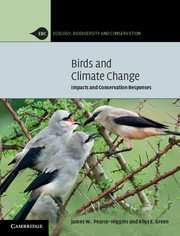Book contents
3 - The impact of altered timings
Published online by Cambridge University Press: 05 June 2014
Summary
Why timing matters
In the previous chapter we saw that many bird species have altered the timing of their migration and breeding as a result of recent climate change. At first sight, the amounts of change seem trivial, averaging 2–3 days advance per decade, but cumulatively they mean that over the last 30 years, birds may now be arriving or breeding a week earlier than they used to. This is important because in many bird species, the timing of these events has evolved to match the timing of peak resource requirements, and therefore any disruption in that timing may affect birds’ breeding success or survival. Most obviously, the time at which birds are rearing their young and need a lot of readily available food often coincides with the greatest abundance of that food. Tits (Paridae) breeding in oak woodland try to maximise the availability of caterpillars, particularly of the larvae of moths such as the winter moth Operophtera brumata, and Tortrix species at the time when nestlings are being reared (Visser et al. 2006; Both et al. 2009). Linked with this, sparrowhawks Accipiter nisus, which find recently fledged tits easy prey, time their reproduction so that the peak abundance of tit fledglings coincides with their own nestling period (Newton 1986; Nielsen & Møller 2006; Both et al. 2009). On the coast, many seabirds breed when large numbers of small fish are maximally available (Durant et al. 2004a, 2004b, 2005). Arctic and upland nesting waterfowl and waders time their breeding to fit in the narrow window of snow-free conditions on the ground, and when there is a superabundance of invertebrate prey (Pearce-Higgins et al. 2005; Meltofte et al. 2007a). The breeding of many tropical species is triggered by rainfall and timed to match peaks in invertebrate or seed resources (Section 2.7).
- Type
- Chapter
- Information
- Birds and Climate ChangeImpacts and Conservation Responses, pp. 63 - 101Publisher: Cambridge University PressPrint publication year: 2014

